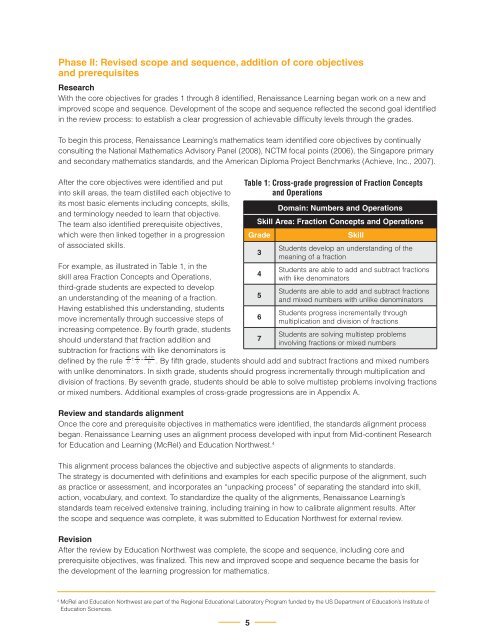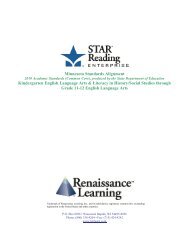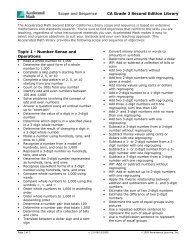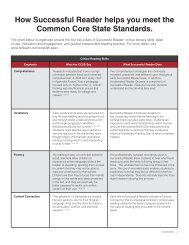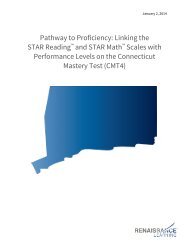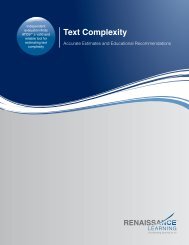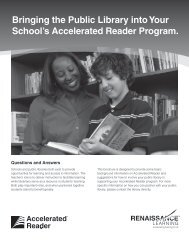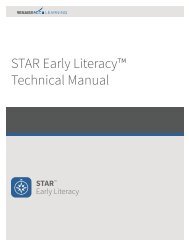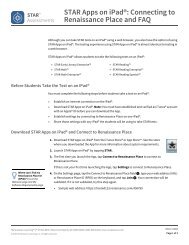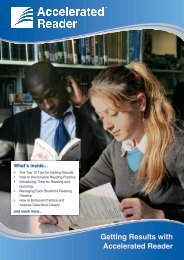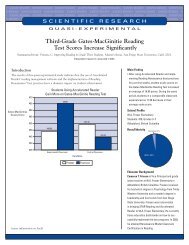Core Progress⢠for Math - Renaissance Learning
Core Progress⢠for Math - Renaissance Learning
Core Progress⢠for Math - Renaissance Learning
You also want an ePaper? Increase the reach of your titles
YUMPU automatically turns print PDFs into web optimized ePapers that Google loves.
Phase II: Revised scope and sequence, addition of core objectivesand prerequisitesResearchWith the core objectives <strong>for</strong> grades 1 through 8 identified, <strong>Renaissance</strong> <strong>Learning</strong> began work on a new andimproved scope and sequence. Development of the scope and sequence reflected the second goal identifiedin the review process: to establish a clear progression of achievable difficulty levels through the grades.To begin this process, <strong>Renaissance</strong> <strong>Learning</strong>’s mathematics team identified core objectives by continuallyconsulting the National <strong>Math</strong>ematics Advisory Panel (2008), NCTM focal points (2006), the Singapore primaryand secondary mathematics standards, and the American Diploma Project Benchmarks (Achieve, Inc., 2007).After the core objectives were identified and putinto skill areas, the team distilled each objective toits most basic elements including concepts, skills,and terminology needed to learn that objective.The team also identified prerequisite objectives,which were then linked together in a progressionof associated skills.For example, as illustrated in Table 1, in theskill area Fraction Concepts and Operations,third-grade students are expected to developan understanding of the meaning of a fraction.Having established this understanding, studentsmove incrementally through successive steps ofincreasing competence. By fourth grade, studentsshould understand that fraction addition andsubtraction <strong>for</strong> fractions with like denominators isa c a ++c= -defined by the rule b - b bTable 1: Cross-grade progression of Fraction Conceptsand OperationsDomain: Numbers and OperationsSkill Area: Fraction Concepts and OperationsGrade. By fifth grade, students should add and subtract fractions and mixed numberswith unlike denominators. In sixth grade, students should progress incrementally through multiplication anddivision of fractions. By seventh grade, students should be able to solve multistep problems involving fractionsor mixed numbers. Additional examples of cross-grade progressions are in Appendix A.Review and standards alignmentOnce the core and prerequisite objectives in mathematics were identified, the standards alignment processbegan. <strong>Renaissance</strong> <strong>Learning</strong> uses an alignment process developed with input from Mid-continent Research<strong>for</strong> Education and <strong>Learning</strong> (McRel) and Education Northwest. 434567SkillStudents develop an understanding of themeaning of a fractionStudents are able to add and subtract fractionswith like denominatorsStudents are able to add and subtract fractionsand mixed numbers with unlike denominatorsStudents progress incrementally throughmultiplication and division of fractionsStudents are solving multistep problemsinvolving fractions or mixed numbersThis alignment process balances the objective and subjective aspects of alignments to standards.The strategy is documented with definitions and examples <strong>for</strong> each specific purpose of the alignment, suchas practice or assessment, and incorporates an “unpacking process” of separating the standard into skill,action, vocabulary, and context. To standardize the quality of the alignments, <strong>Renaissance</strong> <strong>Learning</strong>’sstandards team received extensive training, including training in how to calibrate alignment results. Afterthe scope and sequence was complete, it was submitted to Education Northwest <strong>for</strong> external review.RevisionAfter the review by Education Northwest was complete, the scope and sequence, including core andprerequisite objectives, was finalized. This new and improved scope and sequence became the basis <strong>for</strong>the development of the learning progression <strong>for</strong> mathematics.4McRel and Education Northwest are part of the Regional Educational Laboratory Program funded by the US Department of Education’s Institute ofEducation Sciences.5


